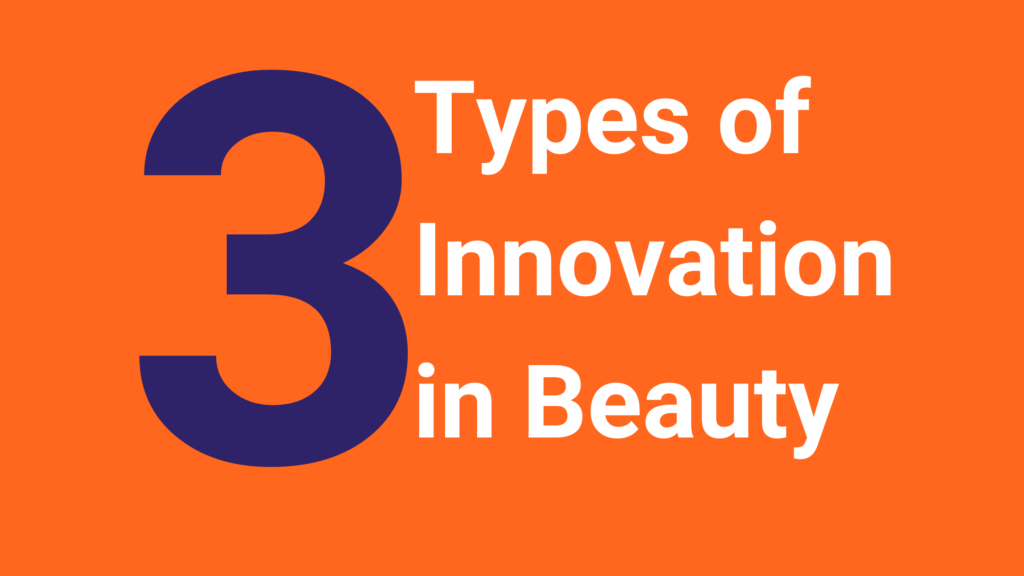On the innovation spectrum, there are three types of innovation for beauty brands, three stopovers from left to right.
-Either you claim to offer higher quality but provide the exact solution to the same problem as other beauty brands
-You offer a new solution to the same problem solved by other beauty brands
-You solve a unique problem, unsolved by anyone else
Each stopover offers some benefits and challenges regarding awareness, trial and adoption.
There is also a 4th stopover(on the extreme left: not shown here), which is when you offer the same quality, the same solution to the same problem as solved by competitors. This is a very tough stopover and usually the domain of mass brands. As an early-stage beauty brand, your chances of failure are the highest on this stopover.
This stopover requires heavy investment in storytelling and advertising.
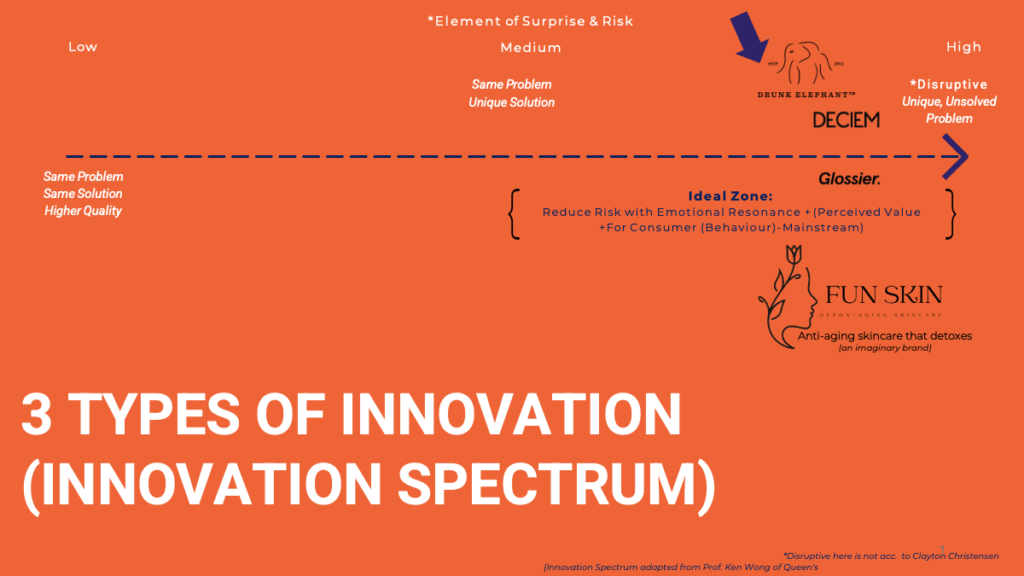
Innovation Stopover 1: Same Problem, Same Solution, Higher Quality
If you have not created a distinct brand story to negate competition, you will have to continuously convince your audience that your quality is better.
Challenges for Innovation Stopover 1 in Beauty
It’s harder to gain attention, be in the consideration stage, help consumers make quality comparisons, and even harder to persuade them to try. If they don’t notice superior results, you won’t get them to be loyal. You have to fight at every stage of the funnel, and you need a lot of marketing resources.
Benefits for Innovation Stopover 1 in Beauty
If you have a captive audience or you can get trials to happen, then trial and adoption are not limited by seeking a change in consumer behaviour. As you become a late growth stage and enter the late mainstream market, one of the biggest challenges to the trial and adopting a solution is the change in consumer behaviour.
Example of a Beauty Brand
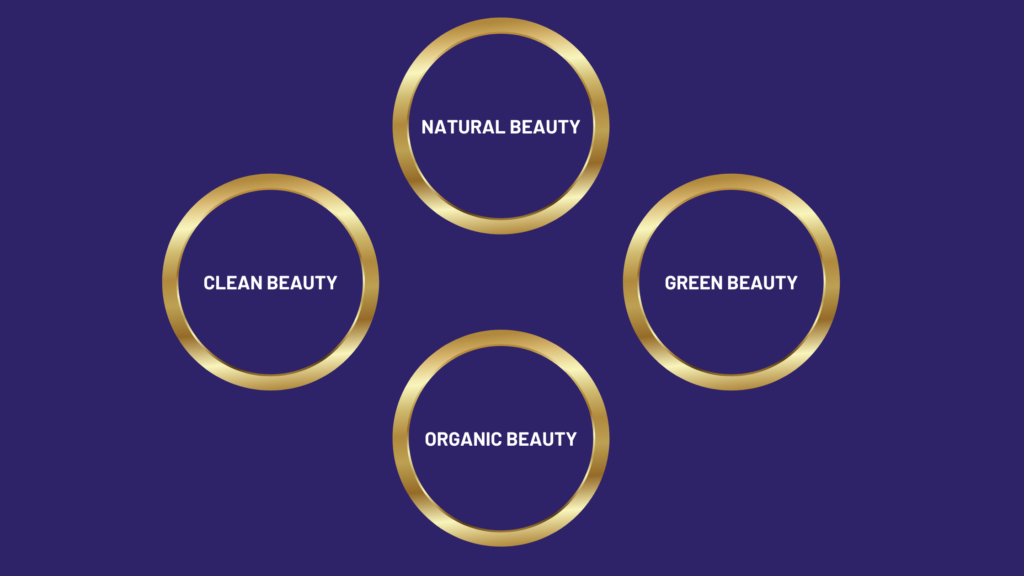
I don’t want to single out beauty brands trying very hard to convince their audience that they are of higher quality. But just go to IG and see most of the clean, natural, organic beauty brands that have no other differentiation or distinctiveness beyond these claims.
If they aren’t leading the clean beauty movement with an ahead-of-the-curve definition, goal, and transparency on progress and the next steps, then they are losing out anyway. They could still perform way better if they show superior performance vis a vis others.
Verdict for Innovation Stopover 1
Move right or transform the brand with an emotionally resonant story to negate competition
Innovation Stopover 2-Same Problem, New Solution
This zone is ideal for early-stage beauty brands as you don’t have to convince and play the “better” game. Your solution is different, and therefore, it negates competition and is a perfect fit with consumers.
Challenges of Innovation Stopver 2
The solution has to be a fit with at least a sizeable audience who can keep their behaviour the same for trial and adoption.
Benefits of Innovation Stopver 3
You will automatically attract attention and enter the persuasion stage for those who perfectly fit the solution. Trials and adoption are also relatively more accessible for the fit category of consumers
Example of a beauty brand
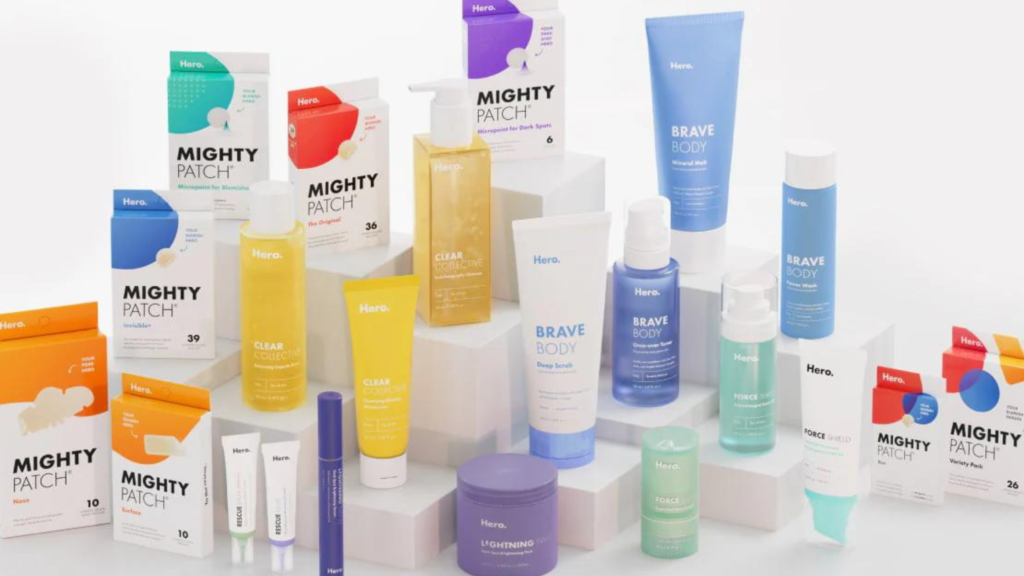
Hero Cosmetics offered patches to treat Acne, a new solution to a problem that other beauty brands were solving with serums, creams, clinical extractions, etc.
The solution was a hit with the younger audience, who hadn’t formed complete skincare routines and wanted quick application and results. They were also the most affected by Acne.
Verdict for Innovation Stopover 2
You can get away with not emotionally transforming your beauty brand for a while until you attract copycats and enter the early-mainstream market. Improving the perceived value of the solution vs. other solutions can also help overcome the barrier to trial and adoption and expand the target consumer base for the novel solution.
New Solution Types for Innovation Stopover 2
Product Format-Hero Cosmetics, as mentioned above. Oils in skincare were a novel solution when they started.
Benefits—Both the benefits of usage and the results: Korean skincare, with its multi-step routines, was a very different solution and ultimately offered very differentiated results.
Features-Personalized skincare solutions and the how of personalizations can be seen as novel
Usage-How you use the products could be new: Korean skincare, e.g.
Disposal-How you dispose of could be more accessible and a better fit
Business model– Innovating with your business model could also create a new solution, as the core problem is the same. Still, now you are making more economic and behavioural sense with a particular segment of consumers. E.g. selling subscription bundles only.
Innovation Stopover 3-Unique, Unsolved Problem
This is the disruptive zone; you are solving a problem that no one has solved before.
Challenges for Innovation Stopover 3
Being disruptive comes with its own challenges to trials and adoption, depending on how aware the target consumer is about the problem. Gaining attention itself will be very difficult if the end consumer is not aware of the problem. Even if she is aware of the problem, there aren’t any solutions around; you need to start from the problem instead of the solution.
Benefits for Innovation Stopover 3
Catches the attention of the early-stage innovators like other beauty founders, PR, Vendors, channels that play at the cutting edge of the category. There is no competition, so it’s not about outbidding but gaining the attention and trial of the end consumer.
Example of a beauty brand
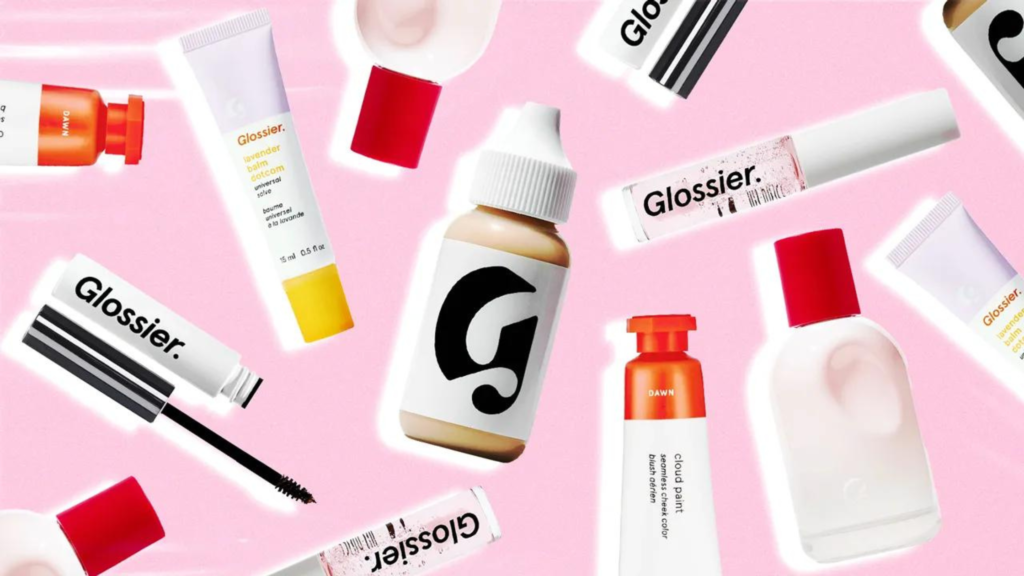
Glossier totally shook up the beauty scene by keeping it real—think minimalist vibes, skincare over makeup, and a tight-knit community vibe. They nailed the digital game, making Insta their playground and letting fans shape the brand. Plus, they made quality beauty affordable and even brought their online buzz to real-life stores.
Glossier raised $80M Series E round in 2021, when the revenue was less than $200M, and has now entered Sephora. The brand has not quite penetrated the late mainstream. That could also be due to dilution of brand differentiation, no longer only focused on skincare, raising prices and launching at retail but without a brick and mortar channel, penetration anyways would have been difficult even though ELF cosmetics has been able to do it.
Another example would be Drunk Elephant, no longer a disruptive solution, but when it launched, it creatively redefined the problem to play in the no-competition, unsolved problem zone of clean compatibility + cool, leading the clean beauty movement with its ahead-of-the-curve definition. DE was between the 2nd & 3rd stopovers when it launched.
DECEIM Is another example of a disruptor with DTC, own brick and mortar stores, masstige pricing 10X less than other prestige brands but equivalent performance.
Verdict for Innovation Stopover 3
High Risk-High Reward Zone. Highly risky zone for consumer adoption especially if it involves a change in consumer behavior, and a bailout is transforming the brand emotionally and removing the barriers to trial and adoption.
SUMMARY
The above innovation spectrum shows three different stopovers on a spectrum and how they differ with relative advantages and drawbacks. If you keep the consumer at the center and then create a differentiated solution, whether with a new solution, solving a new problem or by creative redefinition of the problem, by playing a distinct role in their lives, your chances of success go up big time.
Even though I recommend the ideal zone between stopovers 2 & 3, it also depends on your brand’s growth stage and current performance on the sustainable scale or growth drivers.
If you are a late-growth-stage beauty brand, a high 8—or 9-figure beauty brand, you would need a complete innovation factory that launches new products along the spectrum. There would also be another type of innovation: storytelling campaigns, which are usually the domain of mass brands and can involve heavy paid advertising or distinctive and highly resonant content campaigns.
For the free & full innovation review and strategy and all the tactics, book a free call here!
Do check out my article on 7 strategic ways to up profits during tough times
Jump accelerates women-led, early-stage beauty brands with a”fit, fundamental & fully executable” solution using first principles of diffusion
OR

